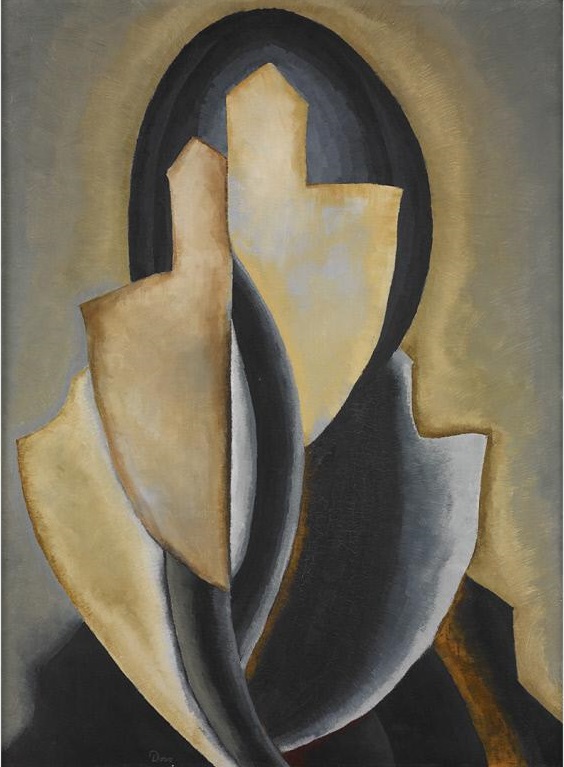Arthur Garfield Dove (1880-1946) is considered one of the earliest American abstract painters. Sunday, August 2 would have been Dove’s 135th birthday.
Dove was born to a well-to-do family in Canandaigua, New York. His father, a brick manufacturer and contractor, named him after the 1880 Republican candidates for President and Vice-President, James Garfield and Chester Arthur. After graduating from Cornell University in 1903, Dove worked as an illustrator for popular magazines such as Harper’s Magazine and The Saturday Evening Post in New York. In 1908-09 he traveled with his first wife Florence to Paris where he joined a group of American Modernists. Among them were Max Weber, Edward Steichen, and Alfred Maurer. Dove and Maurer remained friends until Maurer’s suicide in 1932.
While in Europe, Dove was introduced to European avant-garde art, such as Henri Matisse’s Fauvist paintings. His own early experiments with the new painting styles were successful: his work was included in the annual Autumn Salon in Paris in 1908 and 1909. When he returned to the US, Dove left his career as an illustrator and moved his family to the countryside where he lived by farming and fishing while focusing the rest of his time on his painting. Also soon after his return to the States, Dove met Alfred Stieglitz, who invited the artist to participate in the Younger American Painters exhibition at Stieglitz’s gallery 291 in 1910. He soon became a regular in Stieglitz’s circle of American Modernists, and exhibited alongside painters John Marin and Marsden Hartley, and photographer Edward Steichen. He had his first solo show at 291 in 1912.
In the years 1910 and 1911, Dove painted several innovative works characterized by highly abstract, clearly delineated forms, compressed spaces, rhythmic compositions, and earthy colors. These early experimental works are Dove’s interpretation of visual experiences, and are considered some of the first completely abstract paintings in American art. Besides influences of Fauvism, Cubism, and Wassily Kandinsky’s Expressionism, Dove was also inspired by French philosopher Henri Bergson (1859–1941), who emphasized the importance of a mystical rather than an analytical understanding of the world. Dove explored cycles of growth and renewal in his paintings and analyzed parallels between the visual arts and music.

Arthur G. Dove (1880-1946)
“Moon and Sea No. II”
Oil and metallic paint on canvas
Crystal Bridges Museum of American Art
During the 1920s, Dove explored a wide range of media, including some unconventional materials and techniques to create his abstractions. He produced, for example, a series of experimental collage works, and combined paints like hand-mixed oil or tempera over a wax emulsion. His subjects ranged from abstract portraits and still lifes of domestic objects to agricultural machinery. Although Dove’s abstractions proved to be challenging for the general public, they were admired by the American avant-garde art scene. Stieglitz’s advocacy and commissions for illustrations during these difficult times allowed Dove to make a living as an artist, and to be independent from his critical and unsupportive parents.
Dove met his second wife, Helen Torr, nicknamed “Reds” for her auburn hair, in Connecticut around 1919. The two artists left their unhappy marriages, and lived together on a houseboat named Mona, docked at Halesite on the north shore of Long Island. (You can see a picture of Dove and Torr, as well as the Mona, in the Archives of American Art here.) They eventually married in 1932. Although they endured many periods of hardship and deprivation, the couple shared a commitment to making art.
Life in a maritime environment offered continual inspiration in the forms of watercraft, harbor buildings, and seascapes, which Dove captured in simplified, basic forms with expressive color and line. His knowledge of ocean tides, weather patterns, and seasonal changes also informed these works, as did his interest in symbolic, transcendental color effects he described as “a condition of light.” Dove explained this color phenomena in an autobiographical essay in 1930: “It applied to all objects in nature, flowers, trees, people, apples, cows. These all have their certain condition of light, which establishes them to the eye, to each other, and to the understanding.” [1]

Arthur Garfield Dove, 1880 – 1946
“Two Forms”
1931, oil on board
Crystal Bridges Museum of American Art
Dove painted Crystal Bridges’ Two Forms along the shores of Long Island Sound on February 16, 1931. The work demonstrates the artist’s fascination with sensory experiences and his lyrical approach to nature-inspired abstractions. Reds described the scene in the artists’ joint journal: “A radiant central shape with two roof-like projections at its peak partially obscures a dark, elliptical mass resembling a sun in eclipse.” Guests can view Dove’s painting Moon, 1928, in the Alfred Stieglitz Collection located in Crystal Bridges’ Early Twentieth-Century Art Gallery until September, 2015.
[1] Dove’s text was published in Samuel M. Kootz, Modern American Painters, 1930, available in the Crystal Bridges Library.






